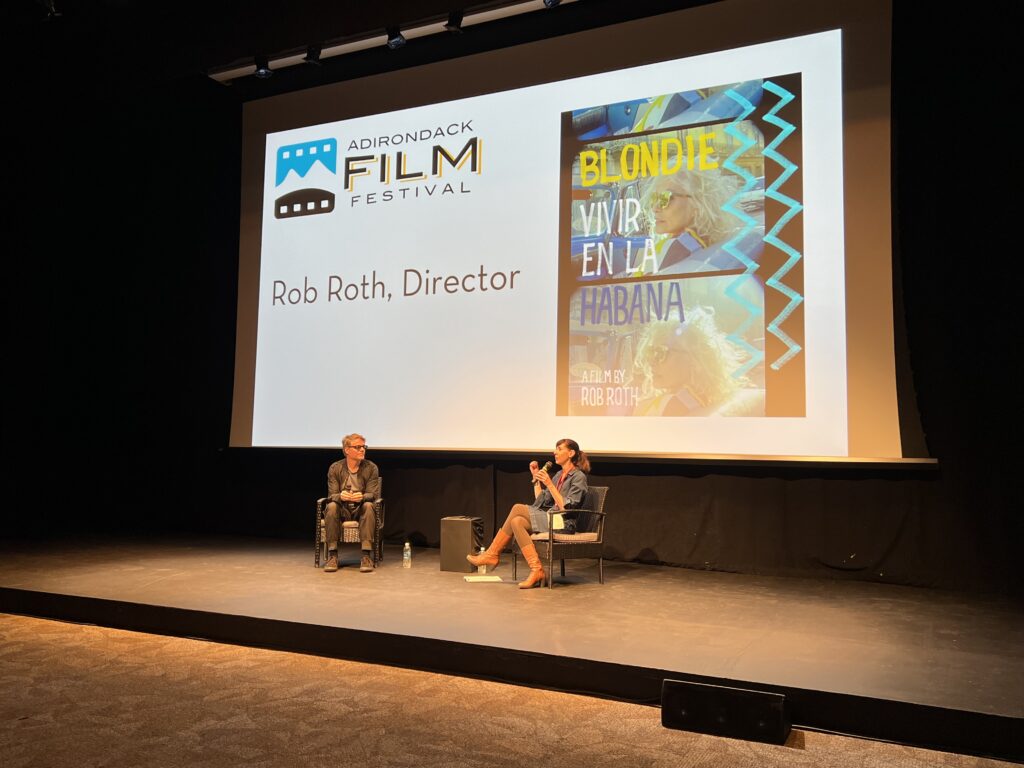Adirondack Film Festival opens with ‘Blondie: Vivir en la Habana’

GLENS FALLS — The 2022 Adirondack Film Festival opened on Thursday night, kicking off its seventh annual celebration of film and theater with a screening of Rob Roth’s ‘Blondie: Vivir en la Habana,’ and a selection of music videos.
Roth was in attendance, and held a Q&A session with Adirondack Theatre Festival producing artistic director Miriam Weisfeld, discussing the documentary and more.
“We’re so happy that you all are here,” Weisfeld said, opening the festival with a welcome to the audience. She noted that roughly 150 people were also streaming the festival virtually, saying it includes filmmakers from places such as New Zealand and “all over the world.”
‘Blondie: Vivir en la Habana’ is a short documentary film showing the band Blondie’s 2019 trip to Havana, Cuba, as part of an official cultural exchange. The band, along with Roth and crew, spent roughly a week in Cuba, performing two shows at the Teatro Mella in Havana.
Roth said the initial idea came from Blondie guitarist and founding member Chris Stein.
“The original genesis was (Stein) always, always wanting to go to Cuba,” said Roth. “I think the previous administration had opened up some sort of dialogue with Cuba… They were doing these things called cultural exchanges. So this was an official cultural exchange invitation from the Ministry of Culture of Cuba.”
Stein ended up being unable to join the band on the trip, with Roth saying he was dealing with heart issues “that kept him from going.” But Roth was intent on documenting the journey, saying it was the first project he had ever pitched to the band.
“They usually come to me,” said Roth. “This is the first thing I said, ‘We have to document this somehow.’ And so we did.”
A majority of the 18-minute documentary was shot on 16-millimeter and 8-millimeter film, Roth said. He initially planned to shoot on iPhones, but made the switch to film after he said Apple pulled out of the project.
“Honestly, the whole thing was an adventure. I didn’t really know what was going to happen,” Roth said. “I didn’t want to explain a lot, I wanted a visceral feeling as much as possible. … It’s almost like a lens to time that they’re stuck in, in a way.”
The film seemed to come together organically, with Roth saying he, “had no idea what the film was really going to be.”
“You have to go with it, you have to enjoy it,” said Roth. “You prepare, prepare, prepare, and then you have to give yourself over. You know when you’re in it, surfing it. You just have to give yourself over, and see how it’s forming, where it’s taking you.”
The documentary is split into three parts, with Roth saying it was initially intended to be three individual short films. Finished in February 2020, the documentary made appearances at film festivals in Italy, the United Kingdom, Iceland, and more.
“The best one was Tribeca. We had a whole night at the Tribeca Film Festival,” said Roth. “Blondie played, and it was the one week where I think the restrictions were lifted. … Everything’s about timing. That was amazing.”
The band was accompanied by local musicians during the concerts, including members of the Cuban band Sintesis.
“The musicians had never met, they had one rehearsal,” Roth said. “It was already set up beforehand, of course, but we were only there for five or six days. … The music was honestly the least difficult part, funny enough. They just met, they all came together and played one rehearsal, and then two nights of shows. It was fantastic.”
The director emphasized the connection brought upon by the music, saying they initially were unsure if the crowd would know Blondie’s music.
“When we were going, Debbie and I were kind of discussing, ‘Do they know the music?,” said Roth. “I always tell this story, I was shooting at one point and there was a balcony. There was a family of, I’m telling you, it was the grandparents down to the grandchildren. And they were all singing. … They knew it. It was so clear that the music had got there.”
“These things are really important,” Roth continued, noting the importance of music and culture in connecting people. “I realized afterwards, that’s the way in. … I do feel like there just needs to be more of that.”
Roth, a native of New York City, has his own connection to upstate New York, noting that his father owned a home in the Catskills.
“It’s very, very special,” Roth said. “It’s a very, very grounding place for me. I need both (the city and upstate).”
As far as future projects from the director, Roth said “there’s nothing greenlit,” but mentioned several ideas potentially in the works.
“We were talking about doing a film about (Harry),” said Roth. “I do a lot of theater too, I’m one of those people that kind of goes back and forth, so there’s two theater projects.”
The Adirondack Film Festival continues today and runs through Saturday. Friday features include ‘Remember This,’ ‘The Quiet Epidemic,’ ‘A Love Song,’ ‘What We Do Next,’ and several series of short films. For more information, visit adkfilmfestival.org.